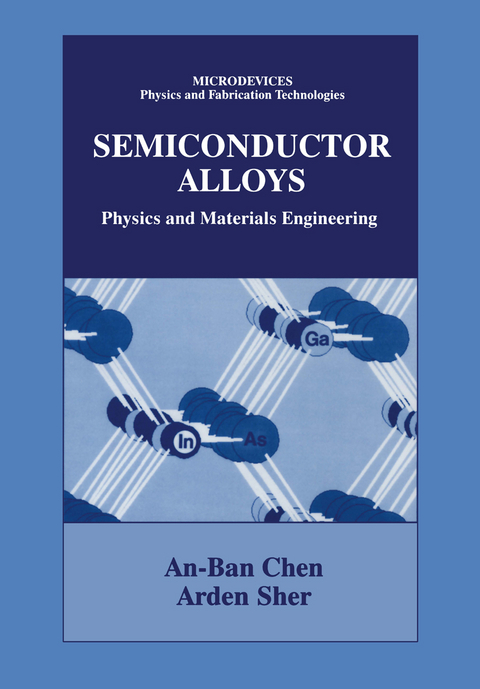
Semiconductor Alloys
Springer-Verlag New York Inc.
978-1-4613-7994-2 (ISBN)
1. Crystal Structures.- 1.1. Diamond, Zinc Blende, and Wurtzite Structures.- 1.2. Bulk Alloys.- 1.3. Alloy Structure Determined by EXAFS.- 1.4. Long-Range Ordered Semiconductor Alloys.- 1.5. Concluding Remarks.- References.- 2. Bonding in Ordered Structures.- 2.1. Cohesive Energy in the Born—Oppenheimer Adiabatic Approximation.- 2.2. Density Functional Theory.- 2.3. Bonds and Bands from Local Density Functional Theory.- 2.4. Tight-Binding Approach.- 2.5. The Bond-Orbital Model.- 2.6. Polarity and Ionicity.- 2.7. Excess Energies of Ordered Alloys.- 2.8. Concluding Remarks.- References.- 3. Elasticity.- 3.1. Definitions and Analysis.- 3.2. Ab Initio Calculations.- 3.3. Valence-Force-Field Model.- 3.4. “Exact” Tight-Binding Calculation.- 3.5. Analytical Expressions in the Bond-Orbital Model.- 3.6. Quantitative Tight-Binding Model.- 3.7. Elasticity in Alloys.- 3.8. Concluding Remarks.- References.- 4. Alloy Statistics and Phase Diagrams.- 4.1. Mixing Free Energy, Miscibility Gap, and Order-Disorder Transitions.- 4.2. Analytical Models.- 4.3. Phase Diagram: Common Tangent Line and Activity Coefficient.- 4.4. Vieland’s Method and Binary Liquidus.- 4.5. Ternary Phase Diagrams.- 4.6. Phase Diagram Data and Simple Mixing Enthalpy Models.- 4.7. Generalized Quasi-Chemical Theory.- 4.8. Internal Strain and Cluster Energies.- 4.9. Sixteen-Bond Microclusters.- 4.10. Cluster Variational Method.- 4.11. Ab Initio Calculations.- 4.12. Concluding Remarks.- References.- Appendix 4A: Analytical Formulas of GQCA.- Appendix 4B: Critical Temperature in GQCA.- Appendix 4C: GQCA at Low Temperature.- 5. Band Structure Theory.- 5.1. Formation of Energy Bands.- 5.2. LCAO and the Empirical Tight-Binding Method.- 5.3. Plane-Wave Method and Empirical Pseudopotentials.- 5.4. Band Gaps andEffective Masses.- 5.5. Band Structure of Semiconductor Alloys: Problems and Applications.- 5.6. Green Function and Spectral Density of States.- 5.7. Perturbation Theory and Bowing of Fundamental Gaps.- 5.8. Multiple Scattering Theory and the Coherent Potential Approximation.- 5.9. A Single-Band Alloy Model.- 5.10. Molecular CPA for Zinc Blende Alloys.- 5.11. Effects of Diagonal and Off-Diagonal Disorder on Band-Edge Properties.- 5.12. Concluding Remarks.- References.- 6. Transport.- 6.1. Master and Boltzmann Equations.- 6.2. Electron—Phonon Interaction and Single-Particle Master Equation.- 6.3. Low-Field Transport for Nondegenerate Electrons in Collision—Time Approximations.- 6.4. Mobilities in Alloys: Example, SixGe1-x.- 6.5. Hot-Electron v—E Characteristics: Comparison of Materials’ Merits.- 6.6. Scattering Mechanisms.- 6.7. Expansion Solution of the Boltzmann Equation.- 6.8. Near-Ballistic Transport.- 6.9. Intervalley Scattering.- 6.10. Narrow-Gap Materials.- 6.11. Concluding Remarks.- References.- 7. Band Structures of Selected Semiconductors and Their Alloys.- 7.1. Hybrid Pseudopotential and Tight-Binding Model (HPT).- 7.2. Band Structures and Hamiltonian Parameters for III–V Constituent Compounds.- 7.3. The HPT Model Applied to III–V Pseudobinary Alloys.- 7.4. Band Structures of Selected III–V Zinc Blende Alloys.- 7.5. Band Structures and Hamiltonian Parameters for II–VI Zinc Blende Compounds.- 7.6. II–VI Zinc Blende Pseudobinary Alloys.- 7.7. Concluding Remarks.- References.- Appendix 7A: Band Structure Calculation Using HPT.- Appendix 7B: VCA Hamiltonian, Alloy Disorder and Molecular ATA Calculation.- 7B.1. The Alloy Hamiltonian in HPT.- 7B.2. The VCA Hamiltonian.- 7B.3. Disorder Hamiltonian and ATA Calculation.- 7B.4. Band Calculation Usingthe Molecular ATA.- Problems.- 1.- 2.- 3.- 4.- 5.- 6.
| Reihe/Serie | Microdevices |
|---|---|
| Zusatzinfo | 364 p. |
| Verlagsort | New York, NY |
| Sprache | englisch |
| Maße | 170 x 244 mm |
| Themenwelt | Naturwissenschaften ► Chemie ► Analytische Chemie |
| Naturwissenschaften ► Geowissenschaften ► Mineralogie / Paläontologie | |
| Naturwissenschaften ► Physik / Astronomie ► Atom- / Kern- / Molekularphysik | |
| Naturwissenschaften ► Physik / Astronomie ► Festkörperphysik | |
| Naturwissenschaften ► Physik / Astronomie ► Thermodynamik | |
| Technik ► Elektrotechnik / Energietechnik | |
| Technik ► Maschinenbau | |
| ISBN-10 | 1-4613-7994-6 / 1461379946 |
| ISBN-13 | 978-1-4613-7994-2 / 9781461379942 |
| Zustand | Neuware |
| Haben Sie eine Frage zum Produkt? |
aus dem Bereich


